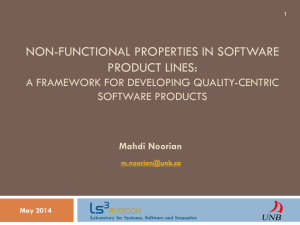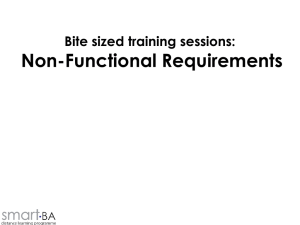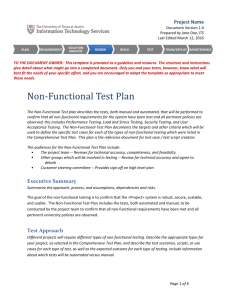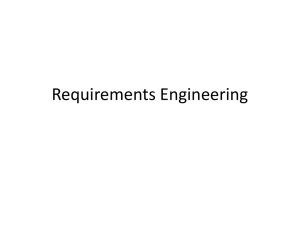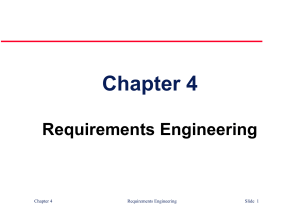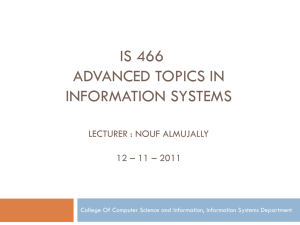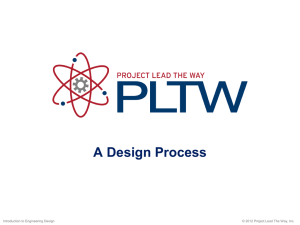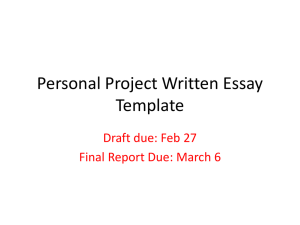slides - Computer Science
advertisement
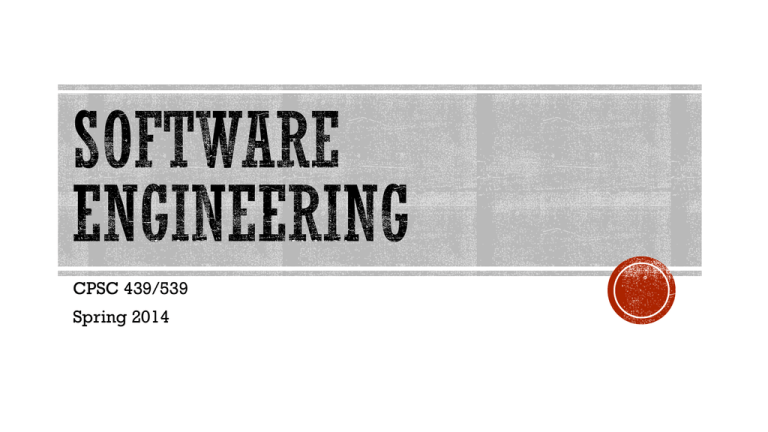
CPSC 439/539
Spring 2014
Saturday, January 25, 2014
10:00 am to 4:00pm
Join us at the Yale CEID (15 Prospect Street) for a day exploring
the variety of opportunities in the growing field of computing!
Open to all, but registration is required. More information at:
www.cs.yale.edu
Many slides courtesy of Rupak Majumdar
Additinally, Rupak thanked Alex Aiken, Ras Bodik, Ralph Johnson, George Necula,
Koushik Sen, A J Shankar
This course is inspired by various courses available on-line that combine software
engineering and formal methods
Alex Aiken’s course at Stanford
Darko Marinov’s course at the University of Illinois
Small changes in the structure of the course (note: no midterm exam!)
Lectures
expected attendance
Project
40%
Code reviewing / feedback
10%
Homework
20%
In class exam (April 21 or 23?)
30%
Additional requirement for graduate students (CPSC 539): research paper
presentation
Learning how to program in a team, working jointly on a larger project
“learn by doing”
Formal methods - focus on improving software quality
Debugging
Run-time monitoring
Program analysis
Model checking
//: requires (x > 0)
def simple (Int x)
//: ensures y > 0
{
??
return y
}
//: requires (x > 0)
def simple (Int x)
//: ensures y > 0
{
val y = x - 2
return y
}
Verification condition:
∀ x. ∀ y. x > 0 y = x - 2 y > 0
//: requires (x > 0)
def simple (Int x)
//: ensures y > 0
{
val y = x - 2
return y
}
Verification condition:
∀ x. ∀ y. x > 0 y = x - 2 y > 0
Preconditions
//: requires (x > 0)
def simple (Int x)
//: ensures y > 0
{
val y = x - 2
return y
}
Verification condition:
∀ x. ∀ y. x > 0 y = x - 2 y > 0
Program
//: requires (x > 0)
def simple (Int x)
//: ensures y > 0
{
val y = x - 2
return y
}
Verification condition:
∀ x. ∀ y. x > 0 y = x - 2 y > 0
Postconditions
//: requires (x > 0)
def simple (Int x)
//: ensures y > 0
{
val y = x - 2
return y
}
Verification condition:
∀ x. ∀ y. x > 0 y = x - 2 y > 0
Formula does not hold for input x = 1
correct
annotations
verifier
formulas
theorem prover
program
no
You have just seen a simple introduction to Hoare triples.
Sir Tony Hoare = Turing Award winner, among other things, the author of Quicksort
12
Should describe requirements in such a way that they are understandable by
system users who don’t have detailed technical knowledge.
User requirements are defined using natural language, tables and diagrams as
these can be understood by all users.
A library system that provides a single interface to a number of databases of
articles in different libraries.
Users can search for, download and print these articles for personal study.
Must determine stakeholders
Anyone who benefits from the system developed
E.g., who’s client and who’s user ?
Try to understand what their needs are
Reconcile different needs/points of view
Interviewing
User stories
Strawmen
Prototypes
One path is obvious
Sit down with client/user and ask questions
Listen to what they say, and what they don’t say
A less obvious path
Master-apprentice relationship
Have them teach you what they do
Go to workplace and watch them do the task
In all types of interviews, get details
Ask for copies of reports, logs, emails on process
These may support, fill in, or contradict what the user said
Recall: client writes user stories
Using client vocabulary
Describe usage scenarios of software
Title, short description
Each user story has acceptance tests
Clarify the story
Will tell you when the customer thinks story is done
Interviews are useful, but
“I know you believe you understood what you think I said, but I am not sure you realize
that what you heard is not what I meant!”
Users/clients may
Not have the vocabulary to tell you what they need
Not know enough about computer science to understand what is possible
Or impossible
Sometimes may lead to restricted functionality
Good idea to gather requirements in other ways, too
Sketch the product for the user/client
Storyboards
Flowcharts
HTML mock-ups
Illustrate major events/interfaces/actions
Anything to convey ideas without writing code!
Write a prototype
Major functionality, superficially implemented
Falls down on moderate-to-extreme examples
No investment in scaling, error handling, etc.
Show prototype to users/clients
Users have a real system – more reliable feedback
Refine requirements
But, significant investment
Needs to be done quickly
Remember, this is just the requirements phase!
Danger of spending too long refining prototype
The prototype becomes the product
Prototype deliberately not thoroughly thought-out
Product will inherit the sub-optimal architecture
Prototype serves as the spec
Prototype is incomplete, maybe even contradictory
When done well, extremely useful
Find out what users/clients need
Not necessarily what they say they want
Use
Interviews
User stories
Strawmen
Rapid prototyping
As appropriate . . .
User Requirements
Statements in natural language plus diagrams of the services the system provides and its
operational constraints. Written for customers.
System Specifications
A structured document setting out detailed descriptions of the system’s functions,
services and operational constraints. Defines what should be implemented so may be
part of a contract between client and contractor.
The distinction is often glossed over
Describe the functionality of the product
Precisely
Covering all circumstances
Move from the finite to the infinite
Finite examples (requirements) to infinite set of possible computations
This is not easy
In principle, specifications should be unambiguous, complete, and
consistent.
Unambiguous: Only one way to interpret the spec
Complete
Include descriptions of all facilities required.
Consistent
There should be no conflicts or contradictions in the descriptions of the system facilities.
In practice, it is almost impossible to produce a complete and
consistent requirements document.
Developer’s
Specification must be detailed enough to be implementable
Unambiguous
Self-consistent
Client’s/user’s
Specifications must be comprehensible
Usually means: not too technical
Legal
Specification can be a contract
Should include acceptance criteria
If the software passes tests X, Y, and Z, it will be accepted
Written in natural language
E.g., English
Example
“If sales for current month are below target sales, then report is to be printed, unless difference
between target sales and actual sales is less than half of difference between target sales and
actual sales in previous month, or if difference between target sales and actual sales for the
current month is under 5%”
Informal specs of any size inevitably suffer from serious problems
Omissions
Something missing
Ambiguities
Something open to multiple interpretations
Contradictions
Spec says “do A” and “do not do A”
Amalgamation
Different requirements mixed together
These problems will be faithfully implemented in the software unless found in the spec
“If sales for current month are below target sales, then report is to be printed, unless difference
between target sales and actual sales is less than half of difference between target sales and
actual sales in previous month, or if difference between target sales and actual sales for the
current month is under 5%”
January: target $100K, actual $64K
February: target $120K, actual $100K
March: target $100K, actual $95,100
Informal specification is universally reviled
By academics
By “how to” authors
Informal specification is also widely practiced
Why?
The common language is natural language
Customers can’t read formal specs
Neither can most programmers
Or most managers / lawyers
A least-common denominator effect takes hold
Truly formal specs are very time-consuming
And hard to understand
And overkill for most projects
Best current practice is “semi-formal” specs
Allows more precision than natural language where desired
Usually a boxes-and-arrows notation
Must pay attention to:
What boxes mean
What arrows mean
Different in different systems!
We’ll see one example (UML) next time
Functional requirements
Statements of services the system should provide, how the system should react to
particular inputs and how the system should behave in particular situations.
Non-functional requirements
constraints on the services or functions offered by the system such as timing
constraints, constraints on the development process, standards, etc.
Domain requirements
Requirements that come from the application domain of the system and that
reflect characteristics of that domain.
Describe functionality or system services
Functional user requirements may be high-level statements of what the system
should do but functional system specifications should describe the system services
in detail.
Prof. Majumdar CS 130 Lecture 3
A library system that provides a single interface to a number of databases of
articles in different libraries.
Users can search for, download and print these articles for personal study.
The user shall be able to search either all of the initial set of databases or select a
subset from it.
The system shall provide appropriate viewers for the user to read documents in the
document store.
Every order shall be allocated a unique identifier (ORDER_ID) which the user shall
be able to copy to the account’s permanent storage area.
Prof. Majumdar CS 130 Lecture 3
Ambiguous requirements may be interpreted in different ways by developers and
users.
Consider the term ‘appropriate viewers’
User intention - special purpose viewer for each different document type;
Developer interpretation - Provide a text viewer that shows the contents of the document.
These define system properties and constraints e.g. reliability, response time and
storage requirements. Constraints are I/O device capability, system
representations, etc.
Process requirements may also be specified mandating a particular process,
programming language, or development method.
Non-functional requirements may be more critical than functional requirements. If
these are not met, the system is useless.
Prof. Majumdar CS 130 Lecture 3
Product requirements
Requirements which specify that the delivered product must behave in a
particular way e.g. execution speed, reliability, etc.
Organizational requirements
Requirements which are a consequence of organisational policies and
procedures e.g. process standards used, implementation requirements, etc.
External requirements
Requirements which arise from factors which are external to the system and its
development process e.g. interoperability requirements, legislative
requirements, etc.
Prof. Majumdar CS 130 Lecture 3
Non-functional
requirements
Organizational
requirements
Product
requirements
Efficiency
requirements
Reliability
requirements
Usability
requirements
Performance
requirements
Portability
requirements
Delivery
requirements
Space
requirements
External
requirements
Interoperability
requirements
Implementation
requirements
Ethical
requirements
Standards
requirements
Privacy
requirements
Legislative
requirements
Safety
requirements
Product requirement
8.1 The user interface for LIBSYS shall be implemented as simple
HTML without frames or Java applets.
Organizational requirement
9.3.2 The system development process and deliverable documents
shall conform to the process and deliverables defined in XYZCoSP-STAN-95.
External requirement
7.6.5 The system shall not disclose any personal information about
customers apart from their name and reference number to the
operators of the system.
Non-functional requirements/specifications may be very difficult to
state precisely and imprecise requirements may be difficult to verify.
Goal
A general intention of the user such as ease of use.
Verifiable non-functional requirement
A statement using some measure that can be objectively tested.
Goals are helpful to developers as they convey the intentions of the
system users.
A system goal
The system should be easy to use by experienced controllers and should be
organized in such a way that user errors are minimised
A verifiable non-functional requirement
Experienced controllers shall be able to use all the system functions after a total
of two hours training. After this training, the average number of errors made by
experienced users shall not exceed two per day.
Conflicts between different non-functional requirements are common in complex
systems
Spacecraft system
To minimise weight, the number of separate chips in the system should be minimised.
To minimise power consumption, lower power chips should be used.
However, using low power chips may mean that more chips have to be used. Which is the
most critical requirement?
Derived from the application domain and describe system characteristics and
features that reflect the domain.
Domain requirements be new functional requirements, constraints on existing
requirements or define specific computations.
If domain requirements are not satisfied, the system may be unworkable.
There shall be a standard user interface to all databases which shall be based on
the Z39.50 standard.
Because of copyright restrictions, some documents must be deleted immediately
on arrival. Depending on the user’s requirements, these documents will either be
printed locally on the system server for manually forwarding to the user or routed
to a network printer.
The deceleration of the train shall be computed as:
Dtrain = Dcontrol + Dgradient
where Dgradient is 9.81ms2 * compensated gradient/alpha and
where the values of 9.81ms2 /alpha are known for different
types of train.
Understandability
Requirements are expressed in the language of the application domain;
This is often not understood by software engineers developing the system.
Implicitness
Domain specialists understand the area so well that they do not think of making the
domain requirements explicit.
Invent a standard format and use it for all requirements.
Use language in a consistent way. Use shall or must for mandatory requirements,
should for desirable requirements
See Reading on the Lectures page
More detailed specifications of system functions, services and constraints than user
requirements.
Intended to be a basis for designing the system.
May be incorporated into the system contract.
In principle, requirements should state what the system should do and the design
should describe how it does this
In practice, requirements and design are inseparable
A system architecture may be designed to structure the requirements;
The system may inter-operate with other systems that generate design requirements;
The use of a specific design may be a domain requirement.
The requirements document is the official statement of what is required of the
system developers.
Should include both a definition of user requirements and a specification of the
system requirements.
It is NOT a design document. As far as possible, it should set of WHAT the system
should do rather than HOW it should do it
IEEE/ANSI 830-1998 (IEEE, 1998)
Defines a generic structure for a requirements document that must be instantiated
for each specific system.
Introduction.
General description.
Specific requirements.
Appendices.
Index.
Requirements set out what the system should do and
define constraints on its operation and implementation
Functional requirements set out services the system should
provide.
Non-functional requirements constrain the system being
developed or the development process.
User requirements are high-level statements of what the
system should do
System specifications are intended to communicate the
functions that the system should provide
A software requirements document is an agreed
statement of the system requirements.
Semi-formal specs using UML


